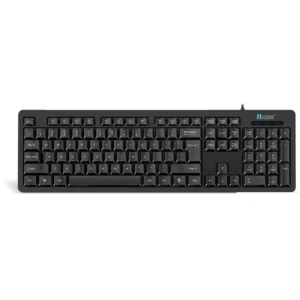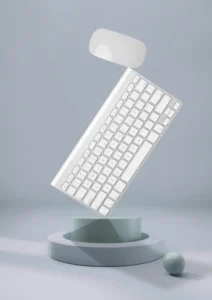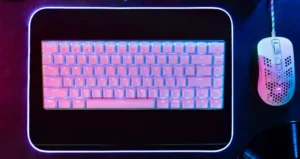Different Types of Computer Keyboards
From mechanical to ergonomic, there are Different Types of Computer Keyboards available today, each suited for different needs and preferences. Selecting the right keyboard can greatly impact your typing comfort, speed, and accuracy. This article will explore the most common categories of computer keyboards so you can determine which is best for your requirements.
Mechanical Keyboards
Mechanical keyboards are popular among gamers and fast touch-typists. They use physical switches under each key to register key presses, providing tactile feedback and a “clicky” response when typing.
Some benefits of mechanical keyboards include:
- Superior tactile feedback – You can actually feel and hear when a key actuates. This allows you to confirm each keystroke and improves typing accuracy.
- Faster response – Mechanical keys have less travel distance to register a keystroke versus membrane keyboards. This can improve typing speed and responsiveness, especially for gaming.
- Higher durability – Mechanical switches are rated for up to 50 million keystrokes. They withstand heavy use better than other types of keyboards.
Mechanical keyboards do come with a higher price point. However, many users find the experience worthwhile, especially if you type all day long.
Wireless Keyboards
Wireless keyboards connect to your computer via Bluetooth or a USB wireless receiver. They allow you flexible placement without being tethered to your computer by a cable.
Key benefits of wireless keyboards:
- Flexibility – Use your keyboard across the room and adjust to a comfortable position.
- Portability – Easily transport your keyboard between rooms or take it traveling.
- Minimal wires – Cut down on clutter from wires snaking across your desk.
One downside is that wireless keyboards require batteries or charging. Also, they can sometimes have minor latency issues during intense gaming sessions. However, technology improvements continue to minimize this.
Overall, wireless keyboards offer outstanding flexibility for most home and office uses.
Membrane Keyboards
Membrane keyboards use a molded sheet of rubber or silicone with electrical contacts below the keys. This sheet detects key presses when contacts connect on the press.
Benefits of membrane keyboards:
- Affordability – They are inexpensive to manufacture, making them one of the most budget-friendly keyboard types.
- Slim profile – Membrane keyboards have a low-profile construction, lying nearly flat. This makes them highly portable.
- Quiet operation – Membrane materials dampen noise significantly compared to mechanical keyboards.
- Water resistance – The membrane keeps out minor spills, making cleaning easier.
However, membrane materials can inhibit typing speed and reduce long term reliability compared to mechanical keyboards. But for basic home and office use, their benefits often outweigh their drawbacks considering their low price point.
Flexible or Foldable Keyboards
Flexible keyboards use a thin membrane surface that can roll, fold, or twist without damaging the electronics inside. Some interesting options in this category include:
Roll-up Keyboards – These ultra slim keyboards can roll into a tight cylinder for storage inside a sleeve or pocket. Highly portable for users on the go!
Foldable Keyboards – Foldable designs allow the keyboard to collapse in sections like an accordion. This reduces the overall footprint when stored away and expands when unfolded for use.
Key benefits of flexible keyboards:
- Extreme portability – Easily fits into bags, sleeves, and some large pockets for travel.
- Space saving – Folds into a smaller size for storage when not being used.
- shard feel – Despite having a membrane surface, many flexible keyboards aim to emulate the responsive feel of laptop keyboards.
The main limitations are that flexible keyboards sacrifice some typing speed and accuracy compared to full size mechanical keyboards. Also, their thin construction feels less sturdy. But the super compact size can outweigh these factors when portability is essential.
Ergonomic Keyboards
Ergonomic keyboards aim to provide better wrist support and a layout tailored to natural hand positioning. This helps reduce strain when typing for long periods.
Some ergonomic design features include:
- Split keyset – Separates left and right hand keys to properly align with natural shoulder width. This prevents over pronation of the wrists.
- Tented angle – Tilts the key rows to better match the resting handshake position.
- Cushioned palmrest – Supports and cushions the palm when resting between keystrokes.
- Alternative key arrangements – Modifies irregular columns common on traditional flat keyboards.
Together these design tweaks provide enhanced comfort, especially for users susceptible to repetitive strain injuries. It does take some adjustment to learn the customized layouts found on ergonomic keyboards. But most people can regain their normal typing proficiency with regular use.
Multimedia Keyboards
Multimedia keyboards incorporate special controls for audio, video, and other media functions beyond standard typing. Typical extra features include:
- Volume and media controls – Buttons to raise/lower volume and pause/play/skip tracks.
- Shortcut keys – Keys mapped to launch media apps like Windows Media Player.
- Jog wheels – A scroll wheel to fast forward/rewind media.
- Extra connectivity – Built-in ports for plugging in thumb drives and memory cards.
These convenient controls allow you to access music and video features without interrupting your workflow to click through software menus. Multimedia keyboards are great for entertainment hubs and home theater PCs.
Projection Keyboards
Projection keyboards display an image of a keyboard onto a flat surface. Built-in sensors detect your finger movements and register key presses on the image.
Benefits provided by projection keyboards:
- Highly portable – With no physical keys, they easily slip into pockets and bags.
- Adaptable surface – Project onto tables, knees, walls – any flat area.
- Seamless sterilization – Easily wipe clean after use.
Drawbacks are reduced tactile feedback, higher errors than physical keys, and requirement of battery power. Still, the tiny size can be handy for travel when a full keyboard is impractical.
Different Keyboards as per Specifications
Beyond the broad categories highlighted so far, keyboards come in an array of sizes and connectivity options. Let’s look at some of the choices.
Computer Keyboard
The traditional full-size keyboards designed for desktop computers and laptops. They have between 100 to 110 keys including the standardized QWERTY layout, number row, function keys, arrow cluster, and numpad. Available wired via USB or PS2 connections and wireless via Bluetooth or USB dongles.
Bluetooth Keyboard
A keyboard utilizing Bluetooth wireless technology to connect with host devices. Bluetooth has an extended range up to 30 feet from the paired device before signal degradation. No line of sight needed between devices. Useful for controlling smart TVs and tablets from your sofa or bed.
Mobile Keyboard
Compact keyboards designed specifically for mobile devices like smartphones and tablets. They are lightweight and slim for tossing in your gear bag. Some offer durable water resistance as well. Great for productivity on the go when you need to do heavy typing on your mobile device.
Lightning Keyboard
Keyboards equipped with an Apple Lightning connector for iOS devices. Allow you to add a comfortable physical keyboard to iPads and iPhones for responsive typing and gaming controls. Draw power directly from the device so no battery needed.
Numeric Keypad
A layout containing just the number keys in calculator format plus math operators. Used to rapidly enter numbers and perform spreadsheet calculations. Often sold as a standalone USB peripheral. Useful if you do a lot of accounting and data entry.

Wired Keyboard
Any keyboard using a physical cable to connect with the host system, usually via USB or sometimes PS/2 ports on desktop PCs. Avoid batteries and provide reliable connectivity during intense gaming. But they limit the range you can position your keyboard.
Conclusion
Keyboards may seem like straightforward computer peripherals, but clearly many types exist beyond the basic office membrane keyboard. Mechanical keyboards deliver a tactile, responsive typing experience suited to heavy typists and gamers. Wireless and flexible keyboards focus on portability for mobile users. Different Types of Computer Keyboards Ergonomic designs aim to reduce muscle fatigue associated with long duration typing. And multimedia keyboards give quick access to viewing and listening controls.
| If you are reading Difference Types of Computer Keyboards then also check our other blogs: | |
| Types of scanner | Web Technology |
Different Types of Computer Keyboard
- What is a scissor-switch keyboard?A scissor switch keyboard uses an X-shaped mechanism under each key to provide a responsive feel when pressed halfway down. This offers a compromise between the short travel of membrane keyboards and full travel of mechanical switches. Scissor switch keyboards feature prominently on many slim laptops.
- What is a gaming keyboard?Gaming keyboards optimize features competitive gamers need. This includes ultra fast mechanical key switches, anti-ghosting technology to ensure multi-key presses register accurately, macro programming for assigning complex game commands, and RGB backlighting for visually striking effects.
- What is a virtual keyboard?A virtual keyboard displays an image of a keyboard on a touchscreen device. You tap the keys shown on the screen rather than physically pressing them. Virtual keyboards save space on devices with compact form factors. They commonly appear on smartphones and tablets whenever text input is required.
